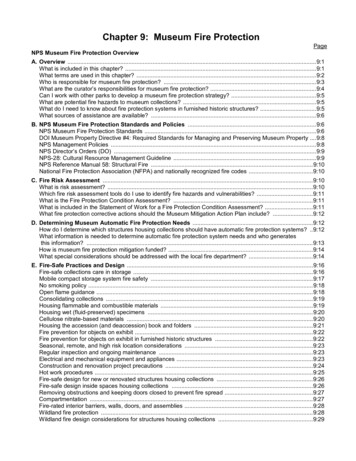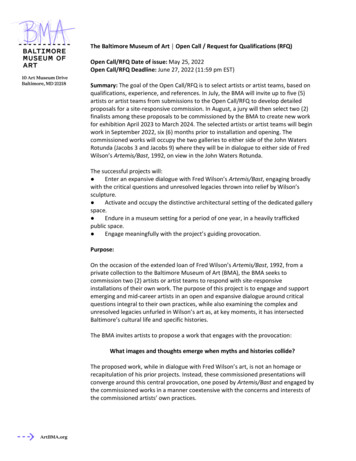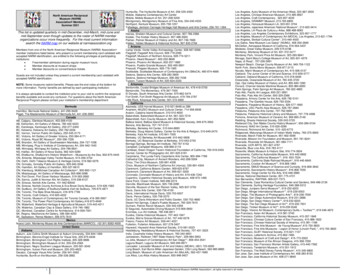
Transcription
Chapter 9: Museum Fire ProtectionNPS Museum Fire Protection OverviewPageA. Overview . 9:1What is included in this chapter? . 9:1What terms are used in this chapter? . 9:2Who is responsible for museum fire protection? . 9:3What are the curator’s responsibilities for museum fire protection? . 9:4Can I work with other parks to develop a museum fire protection strategy? . 9:5What are potential fire hazards to museum collections? . 9:5What do I need to know about fire protection systems in furnished historic structures? . 9:5What sources of assistance are available? . 9:6B. NPS Museum Fire Protection Standards and Policies . 9:6NPS Museum Fire Protection Standards . 9:6DOI Museum Property Directive #4: Required Standards for Managing and Preserving Museum Property . 9:8NPS Management Policies . 9:8NPS Director’s Orders (DO) . 9:9NPS-28: Cultural Resource Management Guideline . 9:9NPS Reference Manual 58: Structural Fire . 9:10National Fire Protection Association (NFPA) and nationally recognized fire codes . 9:10C. Fire Risk Assessment . 9:10What is risk assessment? . 9:10Which fire risk assessment tools do I use to identify fire hazards and vulnerabilities? . 9:11What is the Fire Protection Condition Assessment? . 9:11What is included in the Statement of Work for a Fire Protection Condition Assessment? . 9:11What fire protection corrective actions should the Museum Mitigation Action Plan include? . 9:12D. Determining Museum Automatic Fire Protection Needs . 9:12How do I determine which structures housing collections should have automatic fire protection systems? . 9:12What information is needed to determine automatic fire protection system needs and who generatesthis information? . 9:13How is museum fire protection mitigation funded? . 9:14What special considerations should be addressed with the local fire department? . 9:14E. Fire-Safe Practices and Design . 9:16Fire-safe collections care in storage . 9:16Mobile compact storage system fire safety . 9:17No smoking policy . 9:18Open flame guidance . 9:18Consolidating collections . 9:19Housing flammable and combustible materials . 9:19Housing wet (fluid-preserved) specimens . 9:20Cellulose nitrate-based materials . 9:20Housing the accession (and deaccession) book and folders . 9:21Fire prevention for objects on exhibit . 9:22Fire prevention for objects on exhibit in furnished historic structures . 9:22Seasonal, remote, and high risk location considerations . 9:23Regular inspection and ongoing maintenance . 9:23Electrical and mechanical equipment and appliances . 9:23Construction and renovation project precautions . 9:24Hot work procedures . 9:25Fire-safe design for new or renovated structures housing collections . 9:26Fire-safe design inside spaces housing collections . 9:26Removing obstructions and keeping doors closed to prevent fire spread . 9:27Compartmentation . 9:27Fire-rated interior barriers, walls, doors, and assemblies . 9:28Wildland fire protection . 9:28Wildland fire design considerations for structures housing collections . 9:29
F. Fire Protection Systems and Equipment . 9:29Essential fire protection systems and equipment . 9:30Designing a museum automatic fire protection system . 9:30Selecting automatic fire protection equipment . 9:31Automatic fire detection and alarm systems . 9:32Fire detector types . 9:33Fire alarms and alarm system monitoring . 9:33Automatic fire sprinkler systems and fire suppression systems used in structures housing collections . 9:34Suppression systems not recommended for use in spaces housing collections . 9:34Automatic fire sprinkler system installation . 9:35Commissioning automatic fire protection systems . 9:35Inspection, testing, and maintenance for automatic fire protection systems . 9:36Avoiding unintentional alarms, accidental sprinkler discharge, and system failure . 9:36Portable fire extinguishers types . 9:37Portable fire extinguisher selection for structures housing collections . 9:38Portable fire extinguisher inspection, testing, and maintenance . 9:38G. Museum Fire Section of the Park Structural Fire Management Plan . 9:39What is the park Structural Fire Management Plan (SFMP)? . 9:39What is the Museum Fire Section of the SFMP? . 9:39How do I restrict sensitive information in the Museum Fire Section? . 9:39When does the Museum Fire Section need to be reviewed and updated? . 9:39H. Fire Emergency Response and Salvage . 9:39Implementing fire Emergency Response Steps . 9:40Planning for rapid entry to structures housing collections during a fire . 9:40Posting information for fire emergency response . 9:40Salvage procedures after a fire . 9:40Water damage from fire sprinklers . 9:41Soot and smoke damage . 9:41I. Training, Drills, and Documentation . 9:42Training for portable fire extinguishers . 9:42Fire drills . 9:42Documentation . 9:42J. Selected Bibliography . 9:43K. List of Figures . 9:44Figure 9.1: Museum Fire Protection Cycle . 9:2Figure 9.2: Fire Hazards to Museum Collections . 9:5Figure 9.3: Object Assessment . 9:45Figure 9.3a: Record of the Superintendent’s Decision Regarding Installation of Automatic FireProtection Systems and Consolidation of Collections . 9:47Figure 9.4: Sample Museum Fire Section of Park Structural Fire Management Plan . 9:48Figure 9.4a: Floor Plan: Portable Fire Extinguisher and Fire Alarm Pull Boxes . 9:55Figure 9.4b: Floor Plan: Evacuation Routes . 9:56Figure 9.5: Sample Language for Museum Fire Protection to be Included in a Memorandumof Understanding Between a Park and a Fire Company . 9:57Figure 9.6: Sample Statement of Work for a Fire Protection Condition Assessment (FPCA) . 9:58Figure 9.6a: Attachment to the FPCA Statement of Work: FPCA Questions Related toMuseum Spaces . 9:60Figure 9.7: Comparison of Selected Automatic Fire Sprinkler Systems and Suppression Systemsfor Museum Objects . 9:63Figure 9.8: Comparison of Selected Portable Fire Extinguishers for Museum Objects . 9:64Figure 9.9: Fire Emergency Response Steps . 9:65L. Glossary . 9:66M. Abbreviations Used in this Chapter . 9:69N. Index . 9:70NPS Museum Handbook, Part I, Chapter 9: Museum Fire Protection (2019)
NPS Museum Fire Protection OverviewNPS Museum Fire Protection StandardsInstall automatic fire detection and alarm systems and automatic fire sprinkler and/or suppression systems in structureshousing collections or consolidate collections in structures protected with automatic fire detection and alarm systemsand automatic fire sprinkler and/or suppression systems or document the superintendent’s decision not to install thesesystems or consolidate collections in writing in accordance with NPS Museum Fire Protection Standard (1).Develop and implement a Museum Fire Section of the park Structural Fire Management Plan.Conduct regular self-assessments for fire risk and include corrective actions in the Museum Mitigation Action Plan toremove or reduce fire hazards and vulnerabilities.Store collections in a dedicated storage space, implement no smoking and hot work policies, house paper accession(and deaccession) book and folders in locking UL listed 350 F one-hour fire-resistive insulated filing cabinet, safe, orvault when not in use and store cellulose nitrate-based materials in accordance with fire safety guidelines.Fire Risk AssessmentComplete the NPS Checklist for Preservation and Protection of Museum Collections and update every five years, aswell as the Risk Assessment Worksheet. Arrange for a Fire Protection Condition Assessment of structures housingcollections, to be conducted by a structural fire protection professional.Develop and implement a Museum Mitigation Action Plan to remove or reduce fire hazards to collections and structureshousing collections in collaboration with the Park Structural Fire Coordinator (PSFC), facility manager, Authority HavingJurisdiction (AHJ) or Regional Structural Fire Manager (RSFM), and interdisciplinary team. Review the plan annuallyand update every five years.Determining Museum Automatic Fire Protection NeedsDetermine museum automatic fire protection needs in consultation with the PSFC, AHJ or RSFM, regional curator, andinterdisciplinary team.Work with the facility manager to develop FMSS work orders, PMIS statements, and funding requests for automaticmuseum fire protection systems.Identify special fire protection considerations for collections and structures housing collections in consultation with thelocal fire department.Fire-Safe Practices and DesignStore museum collections in a dedicated storage space with automatic fire protection systems and appropriate firerated assemblies. Containerize collections in well-sealed steel cabinets and mobile compact storage systems. Usefire-resistant materials in structures and in spaces housing collections.Implement fire-safe practices in storage and on exhibit, no smoking and hot work policies, and open flame guidance instructures housing collections. Store the accession book, cellulose nitrate-based materials, and flammable andcombustible materials in accordance with fire safety guidelines. Regularly maintain utilities, equipment and appliances.Fire Protection Systems and EquipmentWork with the AHJ or RSFM and interdisciplinary team to identify, design, select, and install automatic fire detectionand alarm systems and automatic fire sprinkler and/or suppression systems in structures housing museum collectionsin accordance with NPS Museum Fire Protection Standard (1) (MHI 9.B.1.1).Inspect, test, and maintain automatic fire detection and alarm systems, automatic fire sprinkler and/or suppressionsystems, and portable fire extinguishers regularly.Museum Fire Section of the Park Structural Fire Management PlanDevelop and implement a Museum Fire Section of the park Structural Fire Management Plan (SFMP) in consultationwith the PSFC and facility manager. Review annually and update every five years.Restrict distribution of sensitive object information and floor plans in the Museum Fire Section of the park SFMP.Fire Emergency Response and SalvageImplement fire Emergency Response Steps. Implement salvage procedures after the fire scene is cleared for entry.Training, Drills, and DocumentationConduct regular fire drills and ensure staff complete annual fire extinguisher training.Document all museum fire protection activities.NPS Museum Handbook, Part I, Chapter 9: Museum Fire Protection (2019)
CHAPTER 9: MUSEUM FIRE PROTECTIONA. OverviewFire is a major threat to museum collections. It can destroy orirreparably damage irreplaceable collections and structures housingcollections within minutes. Effective fire protection includesprevention, detection, and suppression of fire to prevent ignition and firespread. Implementation of museum fire prevention and protectionpolicies and plans, fire-safe practices and design, and the installation ofautomatic museum fire protection systems and portable fireextinguishers are critical to life safety and the protection of collectionsand structures housing collections.1. What is included in thischapter?This chapter covers museum fire planning and protection for collectionsand structures and spaces housing collections. It includes (in order ofappearance in the chapter): National Park Service (NPS) Museum Fire Protection StandardsSection B: NPS Museum Fire Protection Standards and PoliciesRisk assessments to identify fire hazards and vulnerabilitiesSection C: Fire Risk AssessmentMuseum Mitigation Action Plan that includes corrective actionsimplemented to remove or reduce fire hazards and vulnerabilitiesSection C: Fire Risk Assessment Determining museum automatic fire protection needsSection D: Determining Museum Automatic Fire Protection NeedsFire-safe practices and designSee Section E: Fire-Safe Practices and DesignOverview of automatic fire detection and suppression systems andequipment, including inspection, testing, and maintenanceSection F: Fire Protection Systems and Equipment Overview of portable fire extinguishersSection F: Fire Protection Systems and EquipmentSample Museum Fire Section of the park Structural FireManagement PlanSection G: Museum Fire Section of the Park Structural Fire Management Plan andFigure 9.4: Sample Museum Fire Section of a Park Structural Fire ManagementPlan Fire Emergency Response Steps and salvage proceduresSection H: Fire Emergency Response and Salvage and Figure 9.9: FireEmergency Response StepsTraining, drills, and documentation for museum fire protectionSection I: Training, Drills, and DocumentationFigures and templates for customization by parksNPS Museum Handbook, Part I, Chapter 9: Museum Fire Protection (2019)9:1
This chapter does not address fire prevention, protection andsuppression in laboratories and exhibit preparation areas. Wildland firesin parks are noted only in relation to structures housing collections. SeeRM-18: Wildland Fire Management for additional information.Figure 9.1: Museum Fire Protection Cycle below provides a visualrepresentation of the museum fire planning and protection process,including prevention, detection and suppression, and emergencyresponse and salvage steps.Assess Fire Risk &Identify Fire Hazards &VulnerabilitiesRisk Assessment Worksheet Notify 911NPS Checklist for Preservation & & Park DispatchProtection of Museum CollectionsBefore FireObject AssessmentEvacuate the BuildingFire Protection Condition Assessment Implement Fire EmergencyMuseum Mitigation Action Plan for Fire Response StepsDuring FireDevelop & ImplementMuseum Mitigation Action Plan & Relocate Objects from AffectedMuseum Fire Section of Park AreasStructural Fire Management PlanSalvage within 48 – 72 hoursDetermine Automatic Fire Protection NeedsArrange for Object ConservationImplement Fire-Safe Practices & Design Treatment as NeededFire Protection Systems & Equipment Update Plans &Fire Detection & Alarm SystemsImplement CorrectiveFire Sprinkler / Suppression Systems Actions as NeededAfter FirePortable Fire ExtinguishersFigure 9.1 Museum Fire Protection Cycle2. What terms are used inthis chapter?In this chapter: Automatic fire protection system refers to: automatic fire detection (smoke and heat detectors) and alarmsystemsandautomatic fire sprinkler systems (water-based)and/orautomatic fire suppression systems (gaseous or “clean agent”based)NPS Museum Handbook, Part I, Chapter 9: Museum Fire Protection (2019)9:2
Portable fire extinguishers (“fire extinguishers” or PFEs) refers tomanually-operated devices (dry chemical or water-based) that areused to control small fires. They are used with automatic fireprotection systems; they are not a substitute for automatic fireprotection systems. Structures housing collections refers to museums, museum storagefacilities, centers, furnished historic structures, spaces withinbuildings, visitor centers, and administrative offices housingcollections. Housing refers to storing and/or exhibiting collections. Collections refer to museum objects, specimens, and associatedrecords, archival items, paper and electronic museum records, anddigital collection images. Open flame refers to lit candles, lanterns, fires in open fireplacesand hearths, lit matches, lighters, and smoldering dry materials.See Section L: Glossary.3. Who is responsible formuseum fire protection?All National Park Service staff are responsible for preventing fire,including permanent and seasonal employees, volunteers, interns,concessionaires, and partner and friends groups.The superintendent or center chief has overall responsibility forpreserving and protecting the park’s museum collection, including fireprotection. The curator, as designated custodial officer, is directlyresponsible for the physical care of, and has day-to-day on-siteresponsibility for the museum collection and its fire protection needs.In this chapter, “curator” refers to the museum curator or collateral dutystaff designated as responsible for the collection.As designated by the superintendent, the Park Structural FireCoordinator (PSFC) is responsible for implementing Director’s Order(DO) 58: Structural Fire Management, Reference Manual (RM) 58:Structural Fire Management, and the Park’s Structural Fire ManagementPlan (SFMP).The Authority Having Jurisdiction (AHJ) is the fire and life safetytechnical resource responsible for enforcing nationally recognized firecodes. The AHJ may also be called the Fire Code Official (FCO). TheAHJ is usually the Regional Structural Fire Manager (RSFM), and isreferred to as “AHJ or RSFM” in this chapter. The AHJ or RSFMarranges for the completion of a Fire Protection Condition Assessment(FPCA) that should include collections and structures housingcollections at each park.The park facility manager works with the PSFC, AHJ or RSFM, andcurator to implement the Museum Mitigation Action Plan, work onNPS Museum Handbook, Part I, Chapter 9: Museum Fire Protection (2019)9:3
funding requests, and arrange for the installation, maintenance andinventory of automatic fire protection systems for structures housingcollections.The interdisciplinary team for museum fire protection includes thecurator, AHJ or RSFM, PSFC, park facility manager, park wildland FireManagement Officer, chief of cultural resources, park Physical SecurityCoordinator, and the regional curator, historical architect advisor,cultural landscape specialist, conservator, and other specialists asneeded. The interdisciplinary team should meet regularly to discussupcoming and ongoing projects, compliance, and related issues toensure collaboration on fire protection activities.4. What are the curator’sresponsibilities formuseum fire protection?The curator is responsible for working with the interdisciplinary teamto: Develop and implement the following for fire protection: Risk Assessment Worksheet NPS Checklist for Preservation and Protection of MuseumCollectionsFigure 10.2Appendix F, Figure F.2, Section F: Fire Museum Mitigation Action Plan First Priority Criteria for Object Relocation and Salvage Object Assessment Museum Fire Section of the park SFMP Fire Emergency Response StepsFigure 10.3Figure 10.20Figure 9.3Figure 9.4Figure 9.9Work with the PSFC and AHJ or RSFM to: include structures housing collections in the FPCA conductedby a structural fire protection professionalselect, install, and maintain automatic fire detection and alarmsystems and automatic fire sprinkler and/or suppressionsystems in structures housing collections in accordance withNPS Museum Fire Protection Standard (1) (MuseumHandbook I, Chapter 9.B.1.1 [MHI 9.B.1.1]), in collaborationwith the park facility managerselect appropriate portable fire extinguishersNote: Collateral duty staff responsible for museum collections mustwork with the regional curator when selecting and installing automaticfire protection systems for collections.NPS Museum Handbook, Part I, Chapter 9: Museum Fire Protection (2019)9:4
5. Can I work with otherparks to develop amuseum fire protectionstrategy?Yes. Parks with collateral duty staff responsible for museum collectionsor that are understaffed should work collaboratively with center and/orneighboring park staff with appropriate expertise and the regional officeto develop and implement a museum fire protection strategy for thepark. This includes fire risk assessment, planning, prevention,mitigation, response, and salvage.6. What are potential firehazards to museumcollections?Most structural fires are caused by human activity or carelessness. Theycan occur due to failure to correct one or more of the deficiencies andhazards listed below in Figure 9.2: Fire Hazards to Museum Collections.CategoryCivil Disturbances andCrimeConstruction and/orMaintenanceMuseum and ParkOperations(Procedural)Emergency IncidentsSpecific Fire Hazard Arson Terrorist attack Vandalism Poorly installed and/or maintained automatic firedetection and alarm, automatic fire sprinkler and/orsuppression, HVAC, and electrical systems Inappropriately modified fire detection and alarmsystems and sprinkler and/or suppression systems Use of High Density Polyethylene (HDPE) buildingmaterials Careless hot work Faulty or deteriorated electrical and mechanicalsystems, lighting, and installation Improperly disposed chemicals Deferred maintenance Absence of fire-safe practices and design Smoking Open flames in or near structures housing collections Appliances left on, improperly used, or in poorcondition Inappropriately housed flammable liquids andhazardous collections Earthquake Hazardous materials spill, exposure, and explosion Power outage Severe weather, including lightning strike Volcanic eruption Wildland fireFigure 9.2 Fire Hazards to Museum Collections7. What do I need to knowabout fire protectionsystems in furnishedhistoric structures?Many historic structures are extremely vulnerable to fire due to theirdesign, building materials and components. Without automatic fireprotection, furnished histori
Overview of automatic fire detection and suppression systems and equipment, including inspection, testing, and maintenance . Section F: Fire Protection Systems and Equipment Overview of portable fire extinguishers. Section F: Fire Protection Systems and Equipment Sample Museum Fire Section. of the park Structural Fire Management Plan











